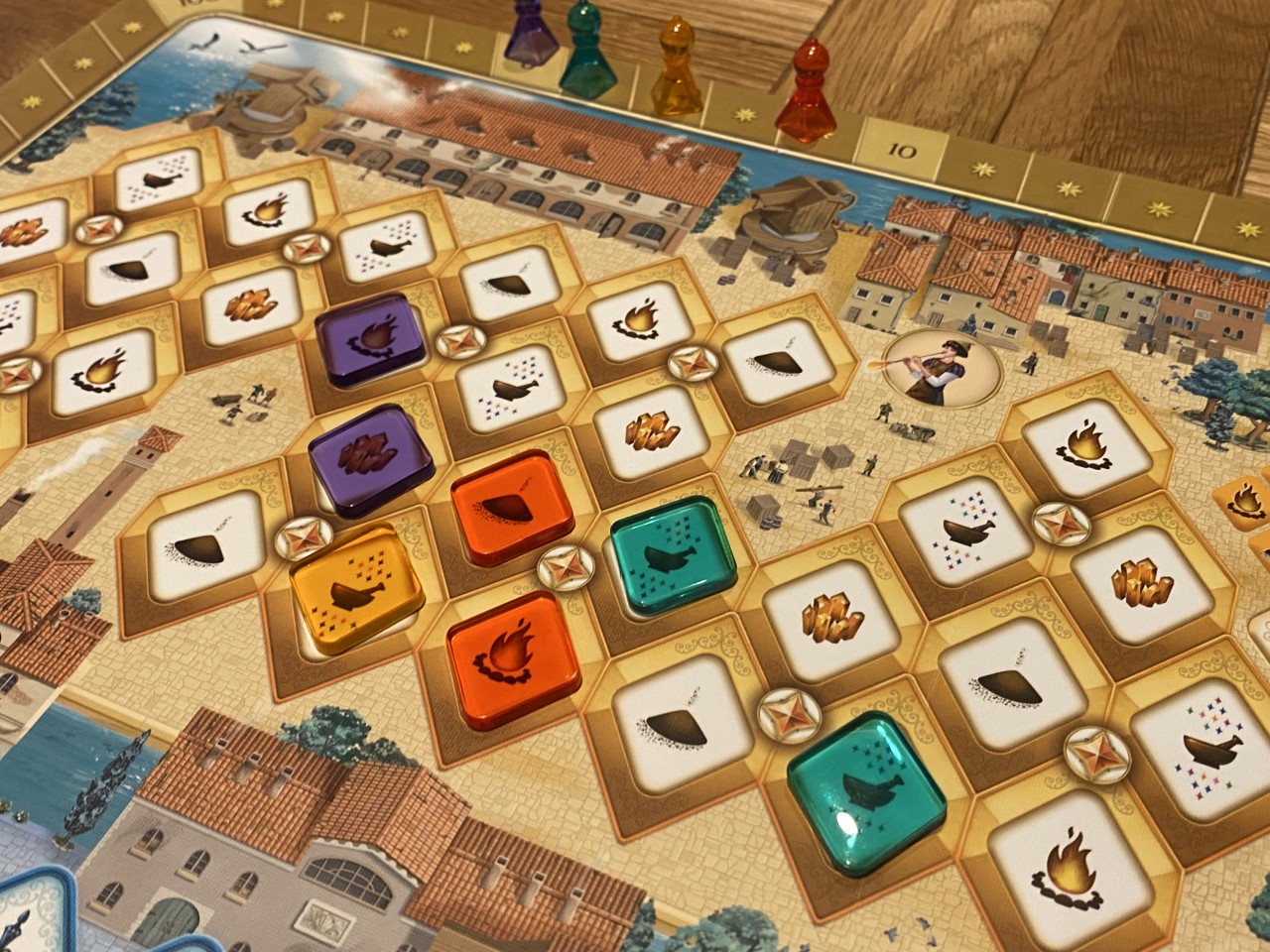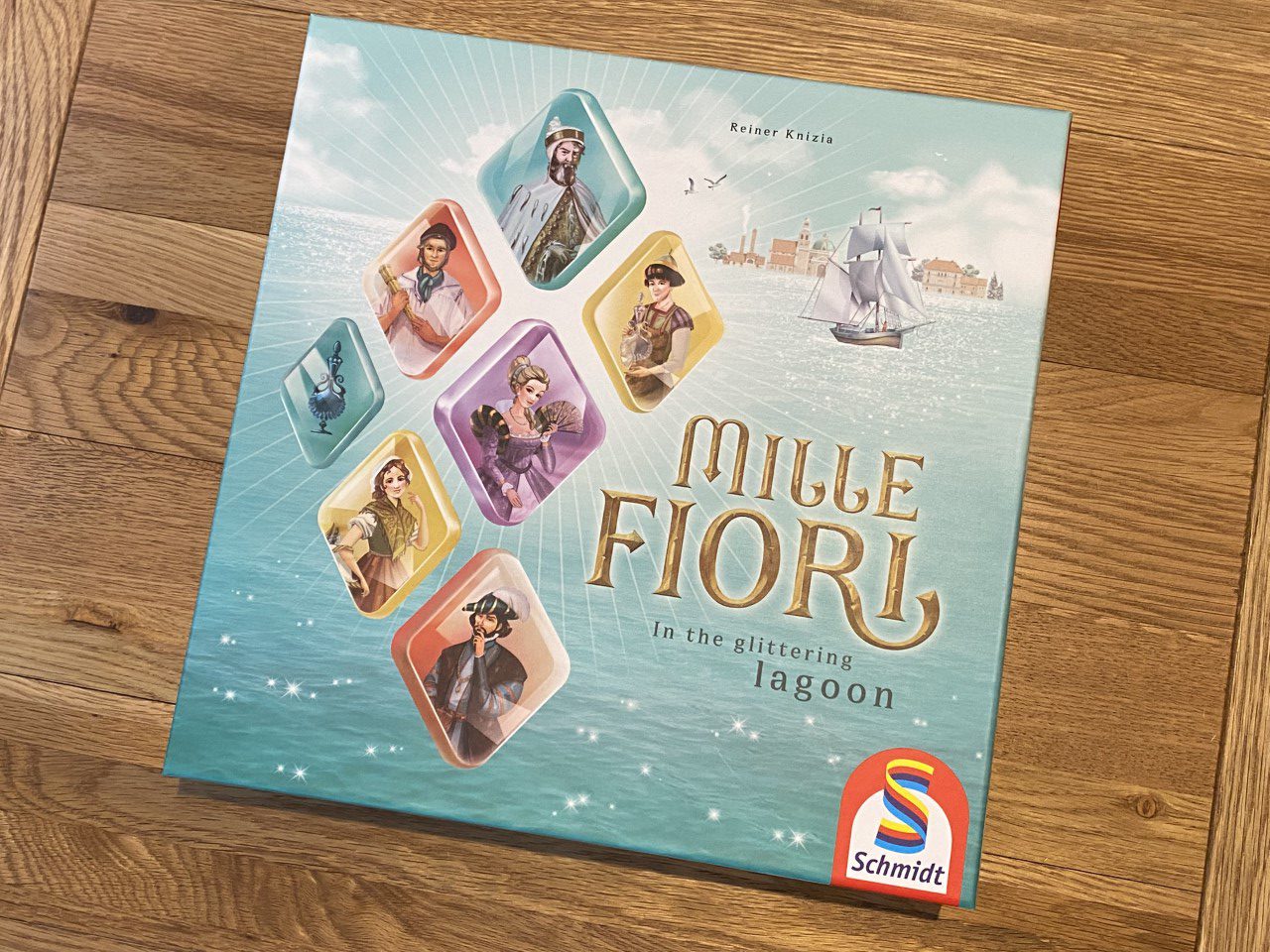Does Reiner Knizia’s Mille Fiori shatter Azul’s reign as the abstract game of choice?
In general, when Dr Reiner Knizia sets his mind to something, the outcome tends to be good. Knizia is responsible for some of our favorite games, with the likes of The Quest for El Dorado, Yellow & Yangtze and Lost Cities among his titles. However, when I declared Azul my favorite light to mid weight game of 2017, I knew it would take something special to replace it as my abstract game of choice. With the release of Knizia’s brand new Mille Fiori, Azul’s dominance has been put to the test.
Mille Fiori is an abstract game that shares remarkable similarity with Azul, but in terms of how it looks and plays, and even down to the very loose theme. In this case, players take on the role of Venetian glassmakers who must influence local people, expand their trading fleet (and access to goods), develop their workshop and invest in property — all of which earn them points.

And points they shall earn, I can tell you. From the very first turn in Mille Fiori you will be scoring. More often than not it will be ones and twos, but some turns will score as many as ten points, with certain special bonus spaces also resulting in secondary actions and even further bonus point opportunities. These can combine for turns worth over twenty points — potentially even more with the potential for actions to chain.
In order to do this, Mille Fiori asks the players to undertake very straightforward turns — in classic Knizia style. At the beginning of each round, the players will draw five cards, choose one, and then pass the remaining four to their neighbour. They will then play their chosen card in turn order (which I will describe in a moment) and then choose one card from the four they were passed and repeat the process. Then one will be chosen from the remaining three and so on until only one card remains — this card will then be placed in a face up display beside the board (which again, I will come to in a moment).
This process is a lot like what is typically called card-drafting in other games, except the difference here is that each drafted card is played before the next is chosen, so players can see how the board has been affected in advance of making their next decision. It’s important to realise at this point that there are around 110 spaces on the board, and each one has a matching card. Whilst this means that there are duplicates (because some spaces are generic, whilst others are grouped together) it is highly unlikely that any one player will get everything they want or need.

And what actually happens when a player places a card? Well, in almost all cases, that card will simply result in one plastic diamond (which represents glass) of the active player’s colour being placed on the matching space — and that player scores points accordingly. Each card matches an area (and sometimes a specific space) on the board, and the colour on each card is mapped to the matching area of the board.
The top left (yellow/brown) area represents the glass workshops of Venice, and here players will place glass pieces on the specific symbols that match the card played. In most cases, each piece placed is worth one point for itself plus each adjacent glass piece owned by that player. If a pigment card (with little dots of colour) is placed, then each adjacent piece of glass is worth two points.

In the purple-ish area in the top right which represents real estate around Venice, the effect is similar, but in this case each piece of glass is placed in sequence from the top left of the track and around and down the right side of the board. Each piece is worth exactly the number of points it covers — which might be as many as ten — plus the points for each matching colour piece of glass behind it. For clarity, if you place a single piece next to an opponent’s piece, you’ll just score the number that piece covers, but if you add another piece adjacent to your own, you’ll score both — and so on each time you extend the chain.
In the greenish area, players will control the local populace — nobles at the top and commoners at the bottom. Here, players will score points for matching the symbols on the board and by building pyramids — the higher up the pyramid you place, the more points you’ll score. The blue area on the left of the board is split into two — the trade area (more trade goods equals more points) and the trade fleet (which only scores for all players who add glass, once any given fleet reaches three glass in total).
All of these areas work fairly similarly, and the demand on the players when selecting their cards is partly about deciding which card (based on the current board state) will score them the most points, weighted against the chance of something changing before the card can be played. Clearly in a three or four player game, this gives a significant advantage to the player who will act first following the selection of cards.

There is one final area of the board which basically features a plastic ship (also made of clear plastic to look like glass — nice) for each player, and simply, these ships follow a set path moving exactly the value shown on a subset of the blue cards (the same ones as fill out the trade fleet). Again, moving a ship along the path simply scores the player points equal to the space the ship lands on.
The one thing that makes the ship track different is that a player can “burn” any card in their hand in order to move their ship the number shown on that card, rather than take the proper action of the card. I didn’t see this happen more than one or two times per game as it feels generally inefficient, however if you know the game is ending and you can force your ship to land on a ten point space, for example, then you may wish to do so.

Another thing to consider when playing your card and choose where to place your glass is the inclusion of bonus spaces — represented by little golden stars. A player can activate these either by covering them, encircling them or through one or two other contextual situations. When a player does so, they may choose one of the face up cards that have been placed beside the board (remember that I mentioned the cards not drafted are placed here) and then take the printed action for free, effectively giving them an extra turn.
Overall, turns in Mille Fiori are extremely fast — often as quick as a matter of seconds. The game lasts pretty much an hour at most, because no matter the player count, the players are going to carry on until either the draw deck is gone, or one player places their last (twenty-seventh) glass tile. On the subject of player count, we do sadly come to the one weakness of Mille Fiori which might actually prevent it from reaching the same heights as Azul.
Firstly, a positive; Mille Fiori is brilliant at three players and fantastic at four players. It is extremely fast-paced in either case and it works really well (especially at four) because of how players are able to plan reasonably well based on board state and turn order, but there is still a need to interact with each other, consider what opponents might do, and have a backup plan.

With two players however, Mille Fiori is more or less broken to the extent that I had to look up errata on BoardGameGeek — only to discover that many other players have said the same. The issue is that when playing with two players, the game is set up with nine cards face up besides the board, and each turn instead of discarding one card each to this display, the players discard two. Turn after turn, there are far, far more cards beside the board than the players will ever use via the bonus spaces and the decision space is massive. It just feels messy.
Speculatively, I think this is because Knizia designs rarely leave much to chance, and given that the deck of cards corresponds more or less exactly to the board spaces, I feel as if the desire was to ensure that the two players had access to every card. At least one fan made variant that I have printed off includes rules to randomly remove up to forty cards from the game at the start and reduce the number that accrue beside the board. This puts both players in a position of equal uncertainty about completing certain areas, forcing them to play their hand and respond to the situation based on a narrower field of vision.]

Despite this issue — which is significant but not insurmountable — I like Mille Fiori a lot. At four players, it absolutely beats Azul as the abstract tile-placement of choice in this house, whilst at three it is still very, very enjoyable. The two player mode comes up short however, despite the best efforts of the community to create variants that help bring a bit more balance to proceedings.
Mille Fiori is a beautifully made, very fast playing, simple to learn abstract game that I think almost anyone could enjoy. You just need to think carefully about who you’ll be playing with — if it’s frequently two or three others, you could be looking at the next big thing among your gaming group. If it’s just you and a gaming partner, try something with more focus on head to head gameplay like 7 Wonders: Duel or Unmatched: Battle of Legends.
You can find Mille Fiori at your local game store, or head over to BoardGamePrices for the lowest possible price online.
Comments are closed.